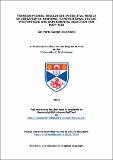Transcriptional regulation in skeletal muscle of zebrafish in response to nutritional status, photoperiod and experimental selection for body size
Abstract
In the present study, the ease of rearing, short generation time and molecular research tools available for the zebrafish model (Danio rerio, Hamilton) were exploited to investigate transcriptional regulation in relation to feeding, photoperiod and experimental selection.
Chapter 2 describes transcriptional regulation in fast skeletal muscle following fasting and a single satiating meal of bloodworms. Changes in transcript abundance were investigated in relation to the food content in the gut. Using qPCR, the transcription patterns of 16 genes comprising the insulin-like growth factor (IGF) system were characterized, and differential regulation between some of the paralogues was recorded. For example, feeding was associated with upregulation of igf1a and igf2b at 3 and 6h after the single-meal was offered, respectively, whereas igf1b was not detected in skeletal muscle. On the other hand, fasting triggered the upregulation of the igf1 receptors and igfbp1a/b, the only binding proteins whose transcription was responsive to a single-satiating meal. In addition to the investigation of the IGF-axis, an agnostic approach was used to discover other genes involved in transcriptional response to nutritional status, by employing a whole-genome microarray containing 44K probes. This resulted in the discovery of 147 genes in skeletal muscle that were differentially expressed between fasting and satiation. Ubiquitin-ligases involved in proteasome-mediated protein degradation, and antiproliferative and pro-apoptotic genes were among the genes upregulated during fasting, whereas satiation resulted in an upregulation of genes involved in protein synthesis and folding, and a gene highly correlated with growth in mice and fish, the enzyme ornithine decarboxylase 1.
Zebrafish exhibit circadian rhythms of breeding, locomotor activity and feeding that are controlled by molecular clock mechanisms in central and peripheral organs. In chapter 3 the transcription of 17 known clock genes was investigated in skeletal muscle in relation to the photoperiod and food content in the gut. The hypothesis that myogenic regulatory factors and components of the IGF-pathway were clock-controlled was also tested. Positive (clock1 and bmal1 paralogues) and negative oscillators (cry1a and per genes) showed a strong circadian pattern in skeletal muscle in anti-phase with each other. MyoD was not clock-controlled in zebrafish in contrast to findings in mice, whereas myf6 showed a circadian pattern of expression in phase with clock and bmal. Similarly, the expression of two IGF binding proteins (igfbp3 and 5b) was circadian and in phase with the positive oscillators clock and bmal. It was also found that some paralogues responded differently to photoperiod. For example, clock1a was 3-fold more responsive than clock1b. Cry1b did not show a circadian pattern of expression. These patterns of expression provide evidence that the molecular clock mechanisms in skeletal muscle are synchronized with the molecular clock in central pacemaker organs such as eyes and the pineal gland.
Using the short generation time of zebrafish the effects of selective breeding for body size at age were investigated and are described in chapter 4. Three rounds of artificial selection for small (S-lineage) and large body size (L-lineage) resulted in zebrafish populations whose average standard length were, respectively, 2% lower and 10% higher than an unselected control lineage (U-lineage). Fish from the L-lineage showed an increased egg production and bigger egg size with more yolk, possibly contributing to the larger body size observed in the early larval stage (6dpf) of fish from this lineage. Fish from S- and L-lineage exposed to fasting and refeeding showed very similar feed intake, providing evidence that experimental selection did not cause significant changes in appetite control. Investigation of the expression of the IGF-axis and nutritionally-response in skeletal muscle after fasting and refeeding revealed that the pattern of expression was not different between the selected lineages, but that a differential responsiveness was observed in a limited number of genes, providing evidence that experimental selection might have changed the way fish allocate the energy acquired through feeding. For example, a constitutive higher expression of igf1a was recorded in skeletal muscle of fish from the L-lineage whereas igfbp1a/b transcripts were higher in muscle of fish from the S-lineage. These findings demonstrate the rapid changes in growth and transcriptional response in skeletal muscle of zebrafish after only three rounds of selection. Furthermore, it provides evidences that differences in growth during embryonic and larval stages might be related to higher levels of energy deposited during oogenesis, whereas differences in adult fish were better explained by changes in energy allocation instead of energy acquisition.
In chapter 5 the main findings made during this study and their impact on the literature are discussed.
Type
Thesis, PhD Doctor of Philosophy
Collections
Items in the St Andrews Research Repository are protected by copyright, with all rights reserved, unless otherwise indicated.

